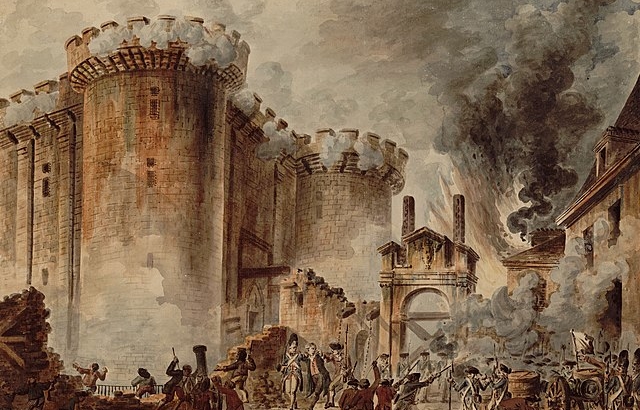American Founding Observations of the French Revolution That Influenced the United States Constitution and Governing
While the drafting of the Constitution of the United States and the French Revolution overlapped, some of the wisdom and differences in the two revolutions help to explain a U.S. Constitution that is designed to prevent regime failure.
One element different between the two revolutions was geographic. Our American Revolution took place on our soil, far away and across the pond from our monarchy rulers, while the French Revolution took place within the country.
More fundamentally, the desired objectives were different in the two revolutions, and that in turn contributed to the ways in which the American Constitution contained provisions to address. The French focused on replacing or changing the existing government. The Americans, on the other hand, wanted to break away and form a government removed from Great Britain. With that in mind, starting with the Declaration of Independence, through the Revolutionary War, and culminating in the Constitution in 1787, the founding fathers inserted wisdom into the form of government and the United States Constitution to help prevent failures they observed in French government.
Learning also from the shortcomings of the Articles of Confederation, which were ratified in 1781 and remained in effect until the Constitution was ratified in 1789, the designers of the Constitution insisted upon branches and a robust system of checks and balances, something lacking in the French structure. The Federalist Papers #51 makes this of vast importance for consideration of the Constitution (emphasis added):
“TO WHAT expedient, then, shall we finally resort, for maintaining in practice the necessary partition of power among the several departments, as laid down in the Constitution? The only answer that can be given is, that as all these exterior provisions are found to be inadequate, the defect must be supplied, by so contriving the interior structure of the government as that its several constituent parts may, by their mutual relations, be the means of keeping each other in their proper places. Without presuming to undertake a full development of this important idea, I will hazard a few general observations, which may perhaps place it in a clearer light, and enable us to form a more correct judgment of the principles and structure of the government planned by the convention. In order to lay a due foundation for that separate and distinct exercise of the different powers of government, which to a certain extent is admitted on all hands to be essential to the preservation of liberty, it is evident that each department should have a will of its own; and consequently should be so constituted that the members of each should have as little agency as possible in the appointment of the members of the others. Were this principle rigorously adhered to, it would require that all the appointments for the supreme executive, legislative, and judiciary magistracies should be drawn from the same fountain of authority, the people, through channels having no communication whatever with one another. Perhaps such a plan of constructing the several departments would be less difficult in practice than it may in contemplation appear. Some difficulties, however, and some additional expense would attend the execution of it. Some deviations, therefore, from the principle must be admitted. In the constitution of the judiciary department in particular, it might be inexpedient to insist rigorously on the principle: first, because peculiar qualifications being essential in the members, the primary consideration ought to be to select that mode of choice which best secures these qualifications; secondly, because the permanent tenure by which the appointments are held in that department, must soon destroy all sense of dependence on the authority conferring them. It is equally evident, that the members of each department should be as little dependent as possible on those of the others, for the emoluments annexed to their offices.”
Conclusion
The United States Constitution’s wisdom is shown in many ways, including with the checks and balances that exist in the Constitution. The careful drafting in 1787 has helped to ensure a continued Constitution that has separations of powers built in and that has ensured that, unlike France and the uncertainty of its revolution and subsequent history, our grand experiment continues 235 years later.
 Daniel A. Cotter is Attorney and Counselor at Howard & Howard Attorneys PLLC. He is the author of The Chief Justices, (published April 2019, Twelve Tables Press). He is also a past president of The Chicago Bar Association. The article contains his opinions and is not to be attributed to anyone else.
Daniel A. Cotter is Attorney and Counselor at Howard & Howard Attorneys PLLC. He is the author of The Chief Justices, (published April 2019, Twelve Tables Press). He is also a past president of The Chicago Bar Association. The article contains his opinions and is not to be attributed to anyone else.
Click here for American Exceptionalism Revealed 90-Day Study Schedule
Click here to receive our Daily 90-Day Study Essay emailed directly to your inbox


 https://en.wikipedia.org/wiki/American_Revolutionary_War#/media/File:Evacuation_Day_and_Washington's_Triumphal_Entry.jpg
https://en.wikipedia.org/wiki/American_Revolutionary_War#/media/File:Evacuation_Day_and_Washington's_Triumphal_Entry.jpg https://en.wikipedia.org/wiki/Napoleon#/media/File:Jacques-Louis_David_-_The_Emperor_Napoleon_in_His_Study_at_the_Tuileries_-_Google_Art_Project.jpg
https://en.wikipedia.org/wiki/Napoleon#/media/File:Jacques-Louis_David_-_The_Emperor_Napoleon_in_His_Study_at_the_Tuileries_-_Google_Art_Project.jpg
good